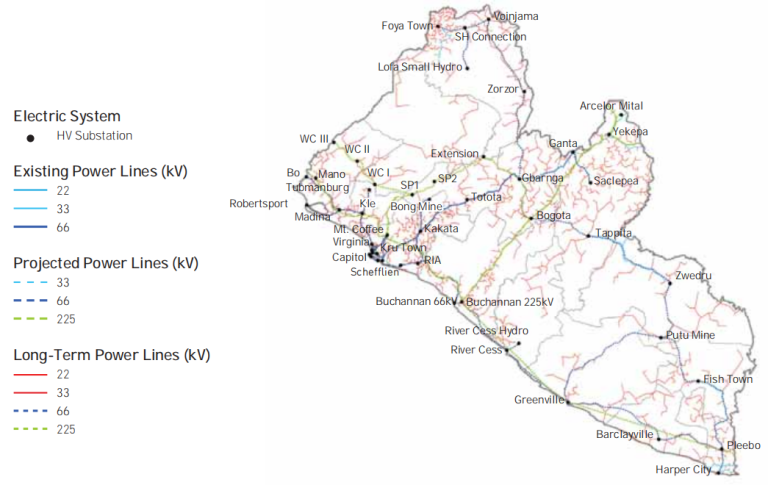The Rural and Renewable Energy Agency (RREA) is mandated by its Legislation to develop in collaboration with the Ministry of Lands, Mines & Energy and other stakeholders a Rural Energy Strategy and Master Plan for Liberia. The Master plan shall be formulated on the basis of well-deined project selection and prioritization criteria designed to ensure enhanced energy access with equity, sustainable development and optimal use of indigenous and renewable resources, and ensure that these are integrated into the national energy Master plan. This document has been prepared in fulfillment of this very important mandate.
1. Liberia Introduction
Liberia’s geography and rural population. Liberia is situated in West Africa, neighboring Sierra Leone, Guinea and others. Liberia is divided into fifteen counties. Monrovia, Liberian capital located in Montserrado county, is the most populous city, with 28% of the total population of Liberia. For the purpose of the Master plan, rural means areas outside of Monrovia, meaning 72% of the country’s population and around 14 000 settlements. This definition differs from the 2008 census where population in several county capitals -19% of the population – were accounted for as urban.
Historical Background. Liberia was created through a settlement of freed slaves from the United States in 1822 and by 1847 the Americo-Liberians were able to establish a republic, thus being Africa’s oldest republic. ln December 1989, the National patriotic Front of Liberia (NPFL), led by Charles Taylor, started a long civil war that lasted until August 11, 2003 when Charles Taylor stepped down and went into exile. After two years of rule by a transitional government, the 2005 Liberian general election were held. ln these elections, President Ellen Johnson Sirleaf, former World Bank employee and Liberian Finance Minister, won the presidential elections and became the first democratically-elected female African head of state in January 2006, being reelected in 2011.
Economic background. Following the first post-war democratic elections in 2005, president Ellen Johnson Sirleaf had the challenge to rebuild Liberia’s economy, and to reconcile a nation still recovering from 14 years of civil war. By the end of the 14 year conlict, most of Liberia,s infrastructures had been destroyed, food insecurity was widespread, poverty rates were high, and many people had been displaced. The economic impact of the civil war was clear: in 2003 Liberia was the second country with lowest Gross Domestic product (GDP) based on Power Purchase Parity per capita in the world. With the restoration of peace, Liberia faced a period of rapid economic growth, experiencing a GDp rate of 7.6% on average in the period of 2004-13, and its nominal GDP more than tripling during this period. The restart of iron ore production encouraged construction and service sector activities.
2. Rural Energy Action Plan
Five programs for rural electriication of Liberia. The Master plan identiies 92 projects and investments to electrify 265 000 homes and 1.34M people outside Monrovia until 2030. The action plan and rural energy projects are structured under 5 main programs
. GTG: Growing the Grid Program: Expanding Medium Voltage grid from the three planned corridors outside of Monrovia (Kakata, Kle andRIA), from new proposed corridors starting from Gbarnga and from the Côted’Ivoire, Liberia, Sierra Leone and Guinea interconnection (CLSG) sub-stations and Shield Wire, representing a total investment of USD 308M and the electriication of 164 300 homes. Additionally, GTG includes additional USD 242M investment in on-grid renewable generation to be installed outside Monrovia.
. DG: Decentralized Grids Program: Building large decentralized grids supported by renewable generation, cross border inter-connections and Medium voltage grids (voinjama, pleebo/Fishtown, zwedru and Greenville); guaranteeing the electriication of the 10 largest settlements in each county, if not under GTG program, than through the development of transitional solar/diesel low voltage mini-grids. Represents a total investment of USD 292M and the electriication of 96 800 homes.
. BTG: Beyond the Grid Program: Electrifying community services, households and public buildings where the grid is not expected before 2025 through 100% solar based off-grid solutions, prioritizing health, education (secondary schools) and security (police stations, checkpoints, courthouses and public lighting); electrifying 75 future off-grid settlements in an equitable way across counties mainly through Solar Home Systems (SHS) while promoting the sale and rental of solar portable lamps or smaller Solar Home Systems across the country. Represents a total investment of USD 16M and the electriication of 4 000 homes.
. OTP: Other than Power Program: promoting eficiency in buildings, appliances and cooking; developing Liqueied petroleum Gas (LpG) storage and illing infra-structure while promoting availability of cooking gas in all county capitals; promoting eficient charcoal production andeficient cook stoves requires a total investment of USD 24M.
. BC: Building capacity: creating the capacity, the institutional framework, the organization, the information and management systems and the infra-structure to implement the Master Plan requires a total investment of USD 52M.
3. Investment requirements and funding strategy
USD 746M still to be funded mostly for the period between 2020and 2030. From the required USD 935M, around USD 140.8M are already committed and an additional USD 45M secured, representing a total of USD 185M – mostly from African Development Bank,world Bank and European Union. Most of the secured funding will be deployed in the irst phase (2016-2020) representing a signiicant part of the estimated investment of USD 262M during that period. A gap of USD 749M remains to implement the Rural Energy Master plan with additional USD 102M being required in the next years, USD 303M between 2020 and 2025 and the remaining until 2030.
A compelling case for funding. The RESMp benefits from a strong initial focus on the electrification of the main cities and towns outside Monrovia (65% of all rural clients in 2030) where there is business activity and some capacity to pay for energy services.
4. Liberia’s Energy Sector and Potential
Liberia’s civil war had severe consequences on the country’s power sector. Before the civil war, more than 7% of the population had access to public electricity – around 35 000 costumers -with a total installed capacity of 191 MW, of which approximately 98% were in and around Monrovia. With the destruction of most of the generation facilities during the war, including the Mount Coffee hydropower plant, as well as of transmission and distribution lines, the Liberian Energy Corporation – national utility in charge of generation, transmission and distribution of electricity – had to cease operations.
On-going reconstruction focused in Monrovia. In the last few years, much effort has been made to resume operations and restore the power sector to pre-war levels in Monrovia. An emergency program allowed for the installation of 22.6 MW of diesel-based generators with very high generation costs. ln July 2010, LEC had around 2 500 customers, a number that increased to around 20 000 by end of 2015: a significant growth, but still less than expectations and less than 10% of Monrovia’s population. potential customers still rely heavily on self-generation given the very high tariff charged by LEC of 55 USD cents per kWh (one of the highest in the world). Several investments to reduce costs and facilitate adoption are currently ongoing: 48 MW of Heavy Fuel Oil based generation at Bushrod and the reconstruction of Mount Coffee Hydro – all focused in Monrovia.
High hydropower potential across the country. Liberia is a tropical country with a very rainy wet season that lasts between April and November and a long seacoast where many rivers end. Hydro potential is very significant in Liberia with 2 300 MW of hydro power potential having been identified under the RESMP study.
Solar and Biomass renewable potential also significant. Addition to hydro, Liberia’s climate also favors two other types of renewable energy with potential for rural electrification: Biomass and Solar. Biomass gasification technology – which has been tested in Liberia with results but some challenges in terms of operation – can become a lower cost alternative to diesel.
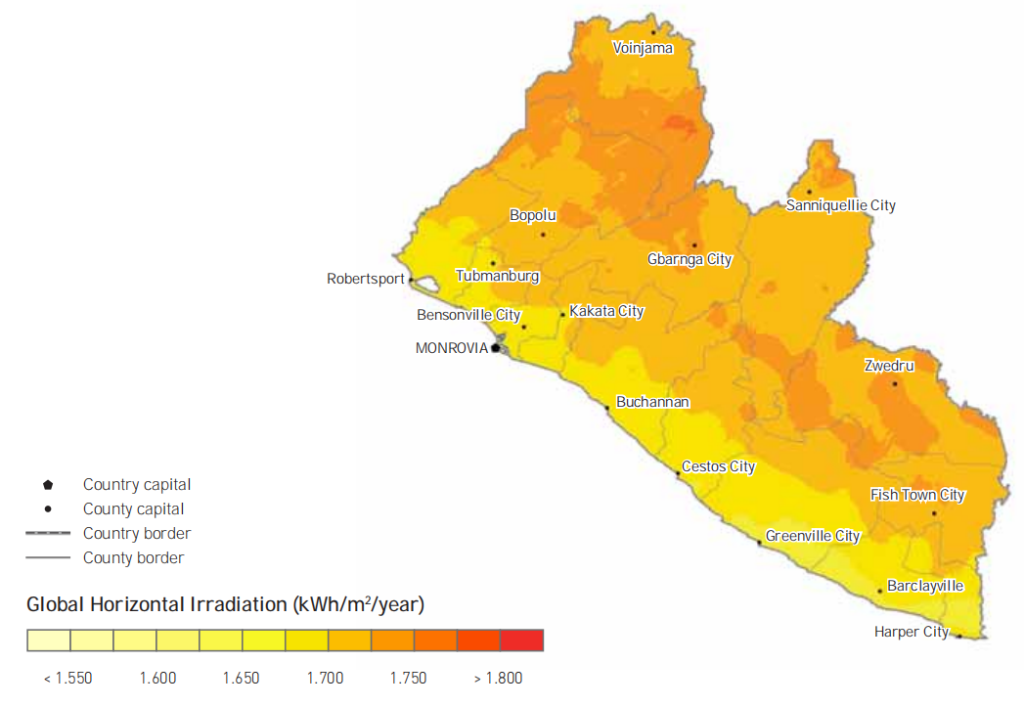
Despite high renewable energy potential, power cost relies mostly on fossil fuels and is one of the most expensive in the world. Many locations across the country offer the potential for lower cost renewable electricity. However, people with electricity access in Liberia face one of the highest costs of electricity in the world with LEC tariffs of USD 0.50 per kWh in Monrovia, and USD 0.25 per kWh in Cross Border project areas with electricity. LEC power is currently generated from fossil fuels, with the Mount Coffee Hydropower expected to come online by the end of 2016.
5. Vision and Objectives for Rural Energy Until 2030
Least Cost Long term vision. The starting point for the Rural Energy Master Plan was the development of a long term vision for the universal electriication of all Liberians – most likely only achievable on the 2050 horizon – using the most advanced geo-spatial network and off-grid planning tools developed by Earth Institute of Columbia University. The resulting Medium Voltage optimal network was than processed by the Consultant to develop a conceptual High Voltage infra-structure with adequate levels of tension for estimated loads and location of HV/MV sub-stations and generation centers that can minimize investments in HV infra-structure while offering adequate n-1 redundancy.
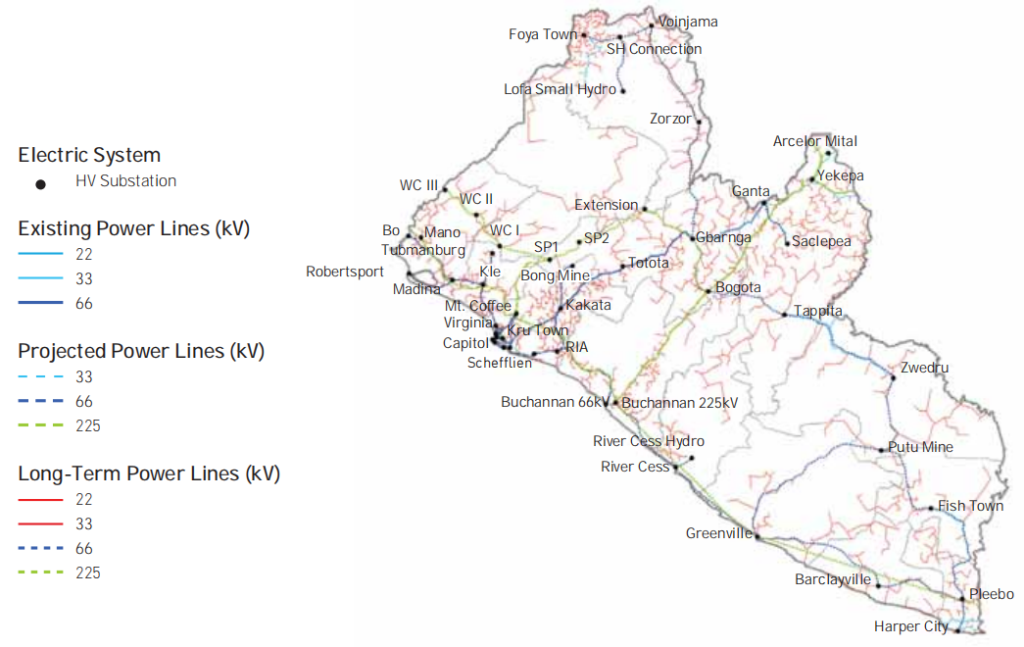
Long term grid results. As can be seen, the resulting National Grid covers a great part of the Country’s populated areas and connects all County Capitals. In the long term the national grid will connect more than 89% of all population, corresponding to 97% of total energy demand. Although the majority of the population is grid connected, only 40% of the inhabited settlements (>5000) are covered by the long term grid. For the remaining 60% (>7000), the least cost option was the off-grid solution based on solar home systems. These off-grid locations are mainly small size settlements with an average size of 115 inhabitants scattered across the country far away from the main roads.
Backwards to 2030. The Rural Energy Master Plan studied four alternative scenarios for the electricity sector in 2030,as seen in Figure 3.2,to reelect the vision and expectations of the different stakeholders interviewed. All the scenarios were based and moved towards the long-term vision, but varied the electrification approach and the level of ambition:
Scenario 1A focused on traditional grid extension with a target of 35% rural electrification by 2030;
Scenario 1B proposed an accelerated and more decentralized electrification approach to reach 35%;
Scenario 2A defended an aggressive national grid extension to reach 50% rural electrification by 2030;
Scenario 2B defended an aggressive investment program both on national grid large, decentralized grids and mini-grids to reach 50%.
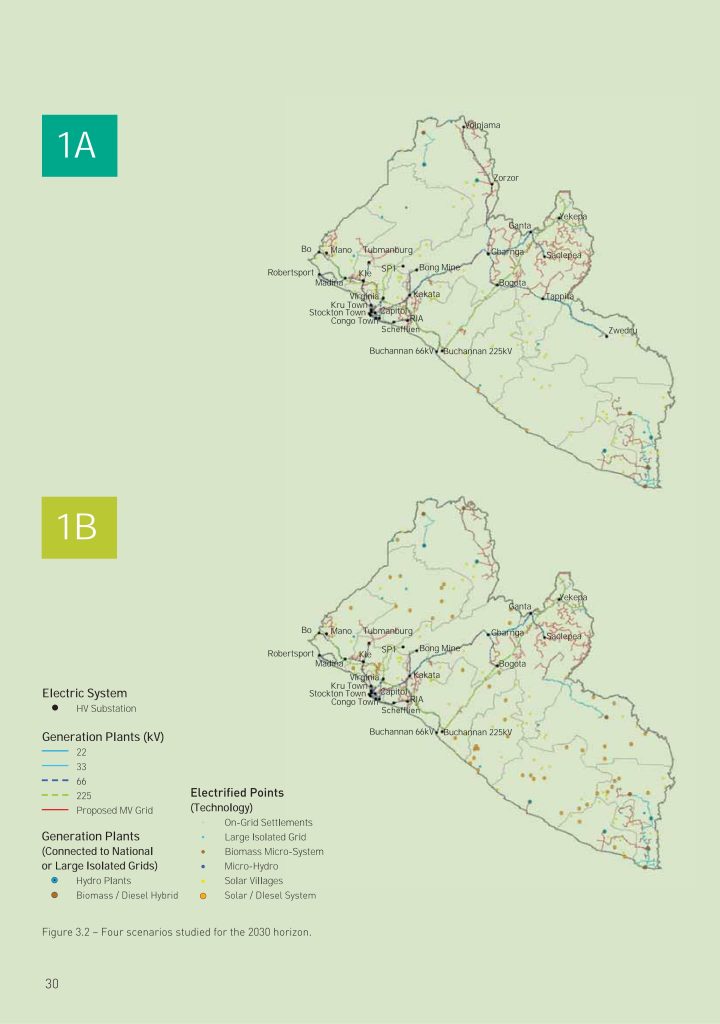
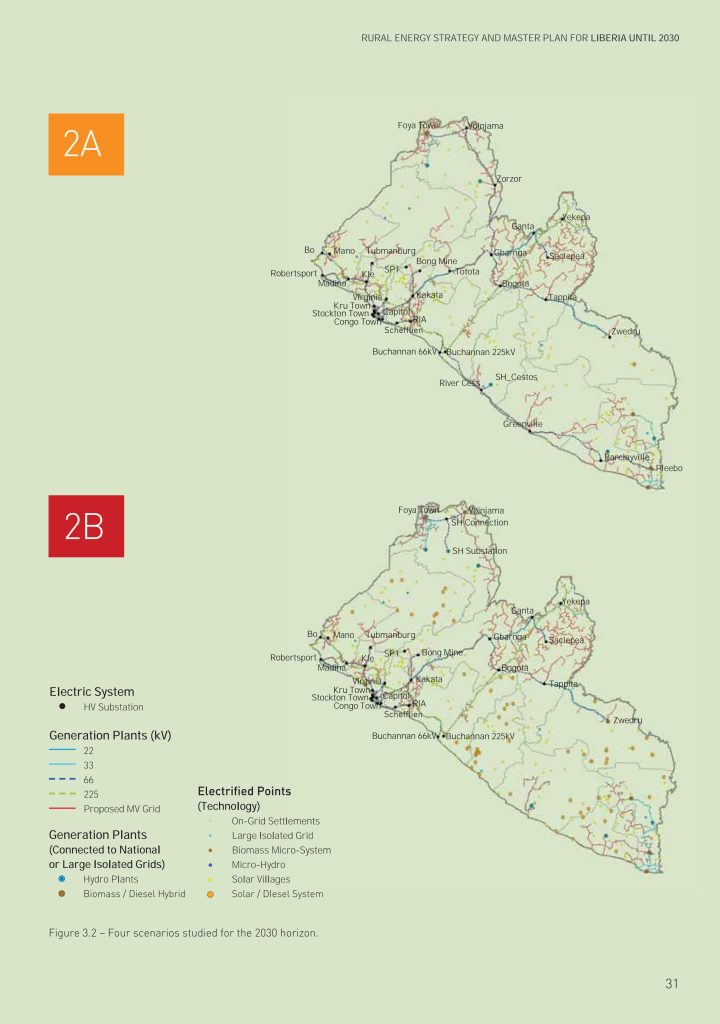
6. Rual Electrification Access Targets and Map
n line with the Sustainable Energy 4 All initiative and the Sustainable Development Goals, Liberia aims to achieve the following in terms of rural electricity access:
• Electriication rate for the population outside of Monrovia of 10% in 2020, 20% in 2025 and 35% in 2030. we intend to electrify outside of Monrovia more than 65 000 customers already by 2020, 140 000 by 2025 and 265 000 by 2035;
• Electrify at least 2 000 settlements with grid infra-structure (national, decentralized or mini grids) connecting at least 50% of those settlement’spopulation by 2030;
• All county capitals will be already electriied before 2025. Electriication of county capitals either through the National Grid,Decentralized Grids or Transitional Mini-Grids will be a priority of the Government.
• All Health facilities and secondary schools electrified already before 2025. We intend to bring electricity to all health facilities and all secondary schools in Liberia either through grid-based electrification or through 100% solar based individual solutions. Leveraging enhanced energy access for improvements in education, health and economic development.
• 10 largest settlements in every county will be electrified and no county will have less than 15% electrification rate by 2030. We intend to take electricity to the largest settlements across the country guaranteeing equity between Counties;
• Establish a credit/subsidy mechanism for connection of poor and woman-led households through REFUND and promote active participation of women in the jobs that will be created for electrifying the country. Energy access has to be inclusive offering opportunities for women and poorer settlements.
This article is from LIBERIA-RURAL-ENERGY-STRATEGY-AND-MASTER-PLAN-REP.pdf (gestoenergy.com)
